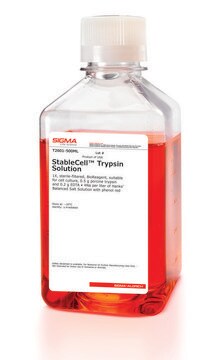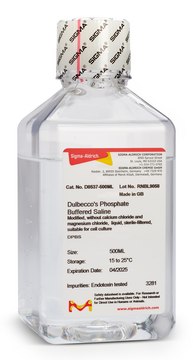T4299
Solution de trypsine-EDTA
1 ×, sterile-filtered, BioReagent, suitable for cell culture, 500 BAEE units porcine trypsin and 180 μg EDTA, 4Na per ml in Dulbecco′s PBS without calcium and magnesium
Synonyme(s) :
Cocoonase, Tryptar, Tryptase
Se connecterpour consulter vos tarifs contractuels et ceux de votre entreprise/organisme
About This Item
Produits recommandés
Source biologique
Porcine pancreas
Stérilité
sterile-filtered
Gamme de produits
BioReagent
Forme
solution
Concentration
1 ×
Technique(s)
cell culture | mammalian: suitable
Impuretés
Porcine parvovirus, none detected (9 CFR)
pH
7.0-7.6
Conditions d'expédition
dry ice
Température de stockage
−20°C
Vous recherchez des produits similaires ? Visite Guide de comparaison des produits
Application
The typical use for this product is in removing adherent cells from a culture surface. The concentration of trypsin necessary to dislodge cells from their substrate is dependent primarily on the cell type and the age of the culture. It can be used with endothelial cell cultures.
Actions biochimiques/physiologiques
Trypsin cleaves peptides on the C-terminal side of lysine and arginine residues. The rate of hydrolysis of this reaction is slowed if an acidic residue is on either side of the cleavage site and hydrolysis is stopped if a proline residue is on the carboxyl side of the cleavage site. The optimal pH for trypsin activity is 7-9. Trypsin can also act to cleave ester and amide linkages of synthetic derivatives of amino acids. EDTA is added to trypsin solutions as a chelating agent that neutralizes calcium and magnesium ions that obscure the peptide bonds on which trypsin acts. Removing these ions increases the enzymatic activity.
Serine protease inhibitors, including DFP, TLCK, APMSF, AEBSEF, and aprotinin, amongst others, will inhibit Trypsin.
Serine protease inhibitors, including DFP, TLCK, APMSF, AEBSEF, and aprotinin, amongst others, will inhibit Trypsin.
Composants
Trypsin consists of a single chain polypeptide of 223 amino acid residues, produced by the removal of the N-terminal hexapeptide from trypsinogen which is cleaved at the Lys - lle peptide bond. The sequence of amino acids is cross-linked by 6 disulfide bridges. This is the native form of trypsin, beta-trypsin. BETA-trypsin can be autolyzed, cleaving at the Lys - Ser residue, to produce alpha-trypsin. Trypsin is a member of the serine protease family.
Attention
This product is stored frozen between -10 and -40°C. Repeated cycles of freezing and thawing should be avoided.
Produit(s) apparenté(s)
Réf. du produit
Description
Tarif
Code de la classe de stockage
12 - Non Combustible Liquids
Classe de danger pour l'eau (WGK)
nwg
Point d'éclair (°F)
Not applicable
Point d'éclair (°C)
Not applicable
Faites votre choix parmi les versions les plus récentes :
Déjà en possession de ce produit ?
Retrouvez la documentation relative aux produits que vous avez récemment achetés dans la Bibliothèque de documents.
Les clients ont également consulté
Carlos Pantoja et al.
Current biology : CB, 30(18), 3647-3656 (2020-08-09)
Interindividual variation in behavior and brain activity is universal and provides substrates for natural selection [1-9]. Selective pressures shift the expression of behavioral traits at the population level [10, 11], but the accompanying changes of the underlying neural circuitry have
Ling Xue et al.
The Journal of nutritional biochemistry, 19(5), 336-344 (2007-08-21)
3,3'-Diindolylmethane (DIM), a major condensation product of indole-3-carbinol, exhibits chemopreventive properties in animal models of cancer. Recent studies have shown that DIM stimulates interferon-gamma (IFN-gamma) production and potentiates the IFN-gamma signaling pathway in human breast cancer cells via a mechanism
Liqin Cao et al.
PLoS genetics, 5(12), e1000756-e1000756 (2009-12-10)
In mammals, observations of rapid shifts in mitochondrial DNA (mtDNA) variants between generations have led to the creation of the bottleneck theory for the transmission of mtDNA. The bottleneck could be attributed to a marked decline of mtDNA content in
Alena Shkumatava et al.
Genes & development, 23(4), 466-481 (2009-02-26)
MicroRNAs (miRNAs) are small noncoding RNAs that direct post-transcriptional repression of protein-coding genes. In vertebrates, each highly conserved miRNA typically regulates hundreds of target mRNAs. However, the precise relationship between expression of the miRNAs and that of their targets has
Jessica Rea et al.
Cancers, 13(15) (2021-08-08)
The impact of protein-coding genes on cancer onset and progression is a well-established paradigm in molecular oncology. Nevertheless, unveiling the contribution of the noncoding genes-including long noncoding RNAs (lncRNAs)-to tumorigenesis represents a great challenge for personalized medicine, since they (i)
Notre équipe de scientifiques dispose d'une expérience dans tous les secteurs de la recherche, notamment en sciences de la vie, science des matériaux, synthèse chimique, chromatographie, analyse et dans de nombreux autres domaines..
Contacter notre Service technique






